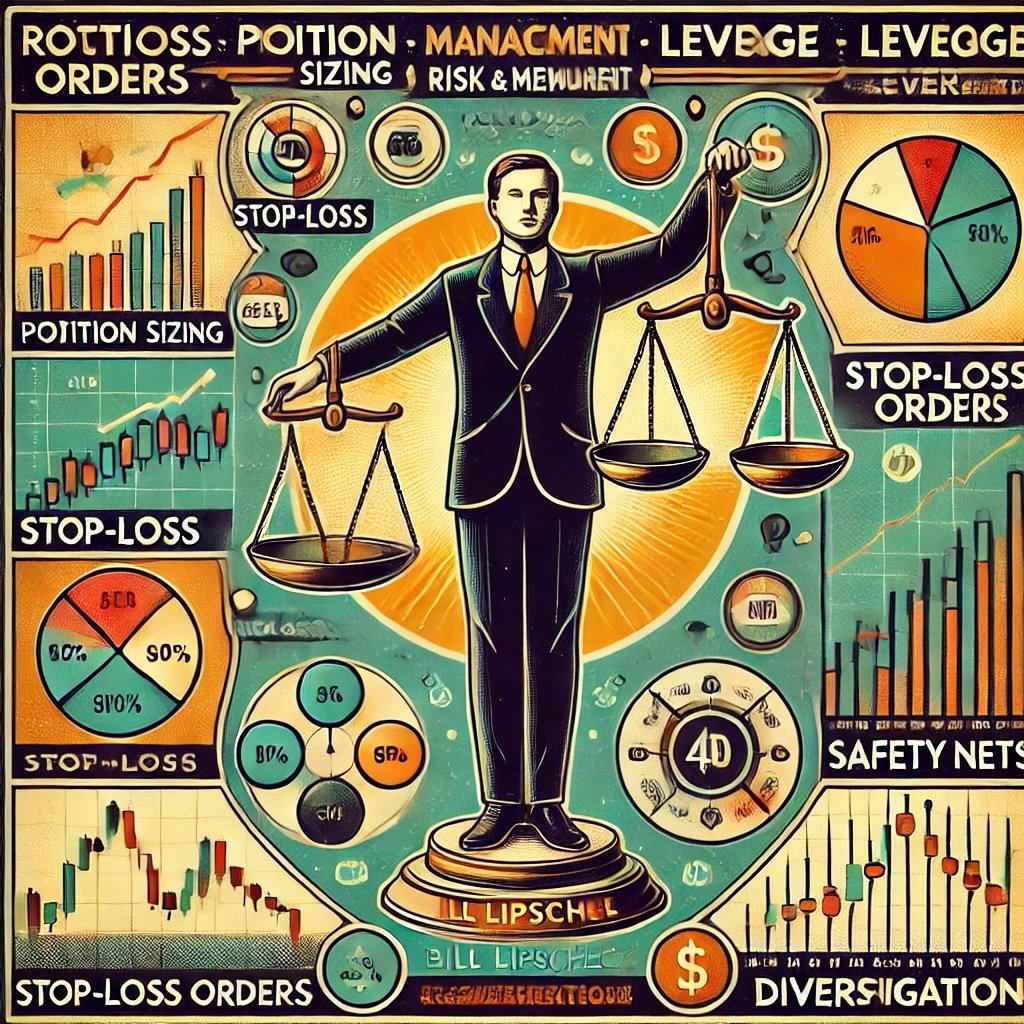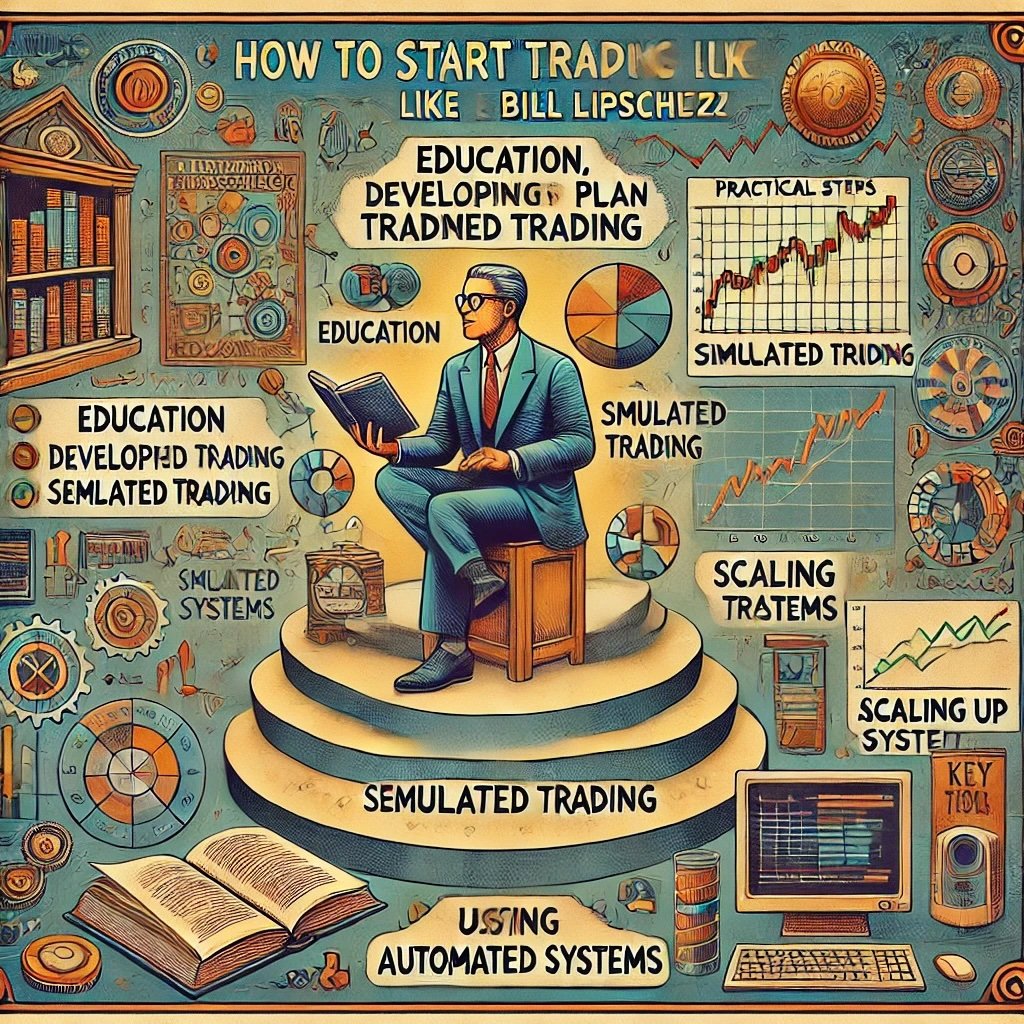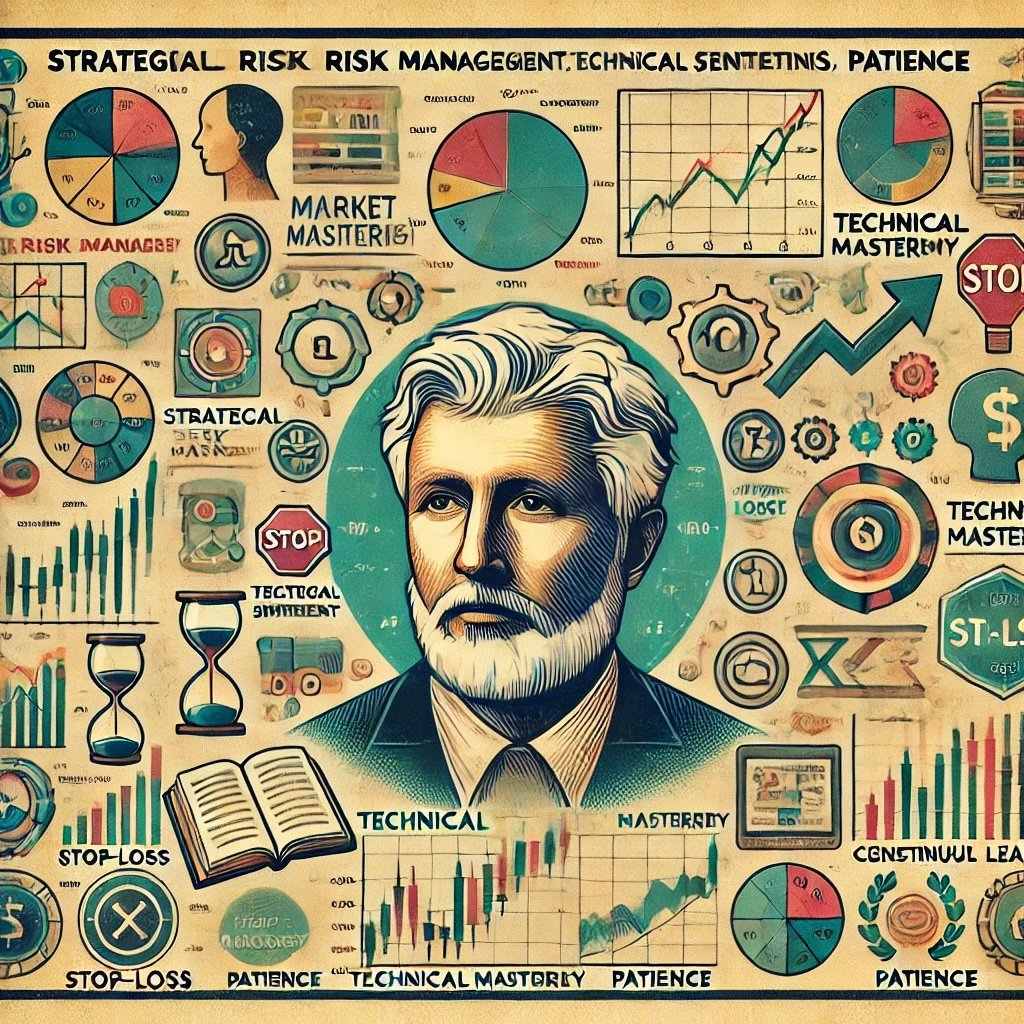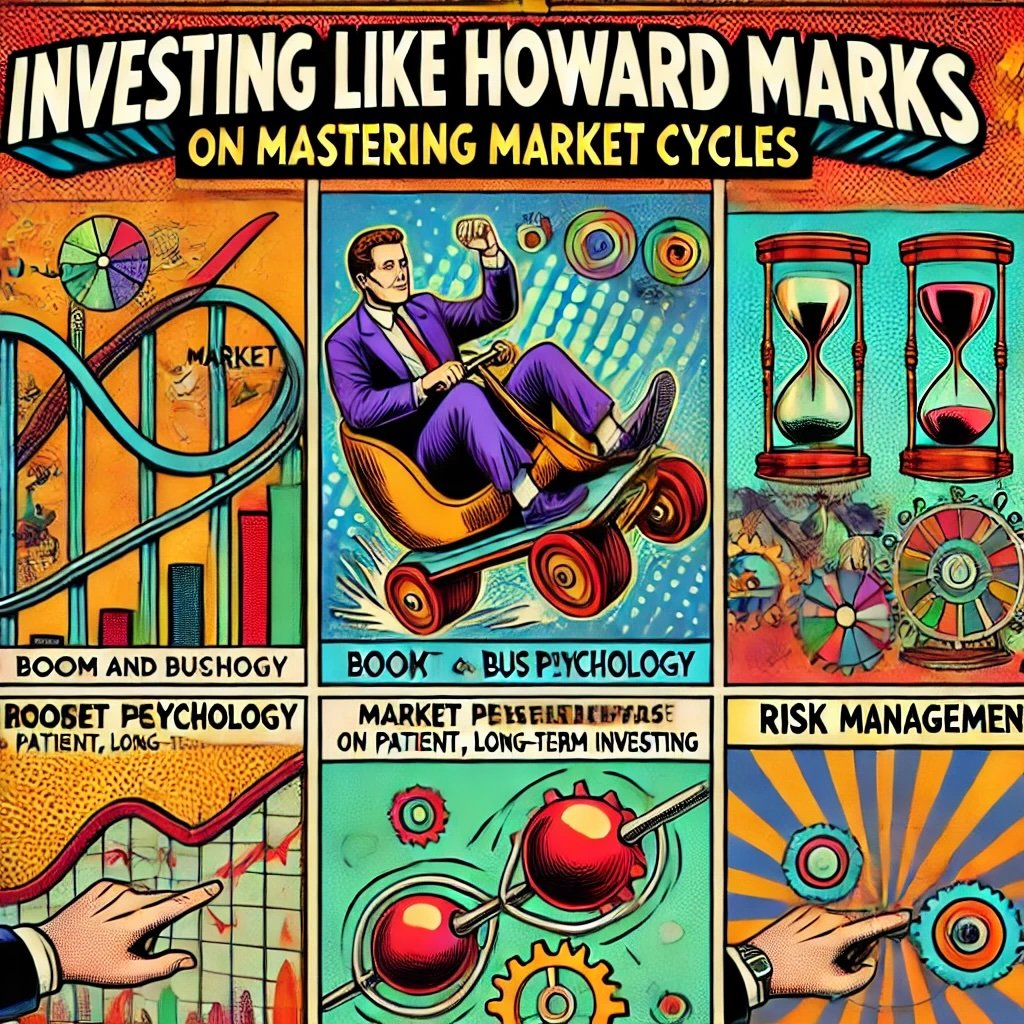Investing like Bill Lipschutz means mastering the art of forex trading, leveraging strategic risk management, and cultivating mental resilience. Known as the “Sultan of Currencies,” Bill Lipschutz has carved out a legendary status in the forex trading world. Whether you’re a novice looking to dip your toes into forex or a seasoned trader aiming to refine your strategies, adopting Lipschutz’s principles can significantly enhance your trading approach. In this comprehensive guide, we’ll delve into Bill Lipschutz’s trading philosophy, explore his core strategies, and provide actionable insights to help you emulate his success in forex trading.
source: Carlos Branco trading on YouTube
Bill Lipschutz: A Titan in Forex Trading
Bill Lipschutz stands as a monumental figure in the realm of foreign exchange (forex) trading. His remarkable journey from a college architecture student to a legendary forex trader underscores the profound impact of strategic thinking and disciplined execution in the financial markets. Lipschutz’s innovative approaches and consistent success have inspired countless traders, solidifying his legacy as one of the greatest forex traders of all time.

Understanding Forex Trading
Forex trading involves the buying and selling of currencies on the global market with the aim of making profits from fluctuations in exchange rates. As the largest financial market in the world, the forex market offers unparalleled liquidity and opportunities for traders. Its significance in global finance cannot be overstated, as it facilitates international trade, investment, and economic stability.
We’ll attempt, as best we can, to explore Bill Lipschutz’s trading strategies and philosophy. By understanding his approach to forex trading, investors can gain valuable insights into creating and implementing their own effective trading systems. From risk management to psychological discipline, we’ll cover the multifaceted aspects that make Bill Lipschutz a legendary figure in the forex trading world.

Who is Bill Lipschutz?
Early Life and Background
Bill Lipschutz was born in New York City, where he developed an early interest in both architecture and finance. Initially pursuing a degree in architecture, Lipschutz found himself increasingly drawn to the dynamics of the financial markets. His analytical mindset, honed through his architectural studies, became a crucial asset in his transition to trading.
Journey from Analyst to Legendary Trader
Lipschutz’s foray into trading began during his college years, where he started experimenting with the stock market. His initial experiences were marked by both successes and failures, teaching him valuable lessons about market behavior and the importance of strategy. After graduation, he embarked on a career in finance, working as an analyst at Salomon Brothers, one of Wall Street’s premier investment banks.
At Salomon Brothers, Lipschutz quickly distinguished himself with his exceptional analytical skills and keen market insights. His ability to interpret complex data and identify profitable trading opportunities led to remarkable success, ultimately earning him the title of U.S. Trading Championship winner in 1984. This achievement catapulted him into the spotlight, solidifying his reputation as a trading genius.
Key Achievements and Contributions
- U.S. Trading Championship Win: In 1984, Lipschutz won the prestigious U.S. Trading Championship, where he tripled his investment within a year, showcasing his exceptional trading prowess.
- Success at Salomon Brothers: As a trader at Salomon Brothers, Lipschutz consistently outperformed his peers, contributing significantly to the firm’s profits and earning accolades for his performance.
- Author and Educator: Beyond trading, Lipschutz has shared his knowledge through books and seminars, helping aspiring traders understand the complexities of forex trading.
- Innovative Trading Systems: Lipschutz is credited with pioneering several forex trading techniques that emphasize technical analysis, risk management, and psychological discipline.

Understanding Forex Trading
What is Forex Trading?
Forex trading involves the exchange of one currency for another in the global foreign exchange market. It operates 24 hours a day, five days a week, providing traders with continuous opportunities to capitalize on currency fluctuations. The forex market is the most liquid and largest financial market globally, with daily trading volumes exceeding $6 trillion.
Significance in Global Markets
Forex trading plays a pivotal role in global finance by enabling international trade and investment. Businesses use forex to convert currencies for cross-border transactions, while investors engage in forex trading to speculate on currency movements and diversify their portfolios. The market’s immense liquidity ensures that trades can be executed swiftly, with minimal price slippage.
Unique Challenges and Opportunities in the Forex Market
Challenges:
- High Volatility: Currency prices can fluctuate rapidly due to economic news, geopolitical events, and market sentiment, posing significant risks.
- Leverage Risks: While leverage can amplify profits, it also magnifies losses, making risk management crucial.
- Market Complexity: The forex market is influenced by a myriad of factors, including interest rates, inflation, political stability, and economic indicators, requiring comprehensive analysis.
Opportunities:
- Liquidity: The high liquidity of the forex market allows for easy entry and exit from trades, even in large volumes.
- 24-Hour Trading: The ability to trade at any time of day provides flexibility and access to global market movements.
- Diverse Trading Strategies: Forex trading accommodates various strategies, including scalping, day trading, swing trading, and position trading, catering to different trader preferences.
Why Bill Lipschutz Chooses Forex as His Primary Trading Focus
Bill Lipschutz gravitates towards forex trading due to its global nature, high liquidity, and constant opportunities for profit. The ability to leverage technical analysis and his disciplined approach to risk management makes forex an ideal market for his trading style. Additionally, the interconnectedness of global economies provides a rich tapestry of data and trends that Lipschutz adeptly analyzes to inform his trading decisions.

Core Principles of Bill Lipschutz’s Trading Strategy
Bill Lipschutz’s trading success is anchored in several core principles that guide his decision-making and execution. These principles ensure that his trading remains disciplined, strategic, and resilient to market fluctuations.
1. Risk Management: Controlling Risk in Volatile Forex Markets
Risk management is the cornerstone of Lipschutz’s trading philosophy. In the volatile forex market, controlling risk is paramount to preserving capital and ensuring long-term success.
Key Aspects of Lipschutz’s Risk Management:
- Position Sizing: Determining the appropriate amount to invest in each trade based on the level of risk. Lipschutz often limits his exposure to a small percentage of his total portfolio per trade.
- Stop-Loss Orders: Setting predefined exit points to limit potential losses. By using stop-loss orders, Lipschutz ensures that a single trade does not result in significant capital erosion.
- Leverage Management: While leverage can amplify returns, it also increases risk. Lipschutz employs conservative leverage levels to mitigate potential losses.
- Diversification: Spreading investments across various currency pairs and asset classes to reduce the impact of adverse movements in any single market.
2. Market Sentiment: Gauging and Utilizing Market Sentiment
Understanding and interpreting market sentiment is crucial for identifying trading opportunities. Lipschutz leverages market sentiment to inform his trading decisions and anticipate future price movements.
Techniques for Gauging Market Sentiment:
- News Analysis: Monitoring economic news releases, geopolitical developments, and central bank announcements that can influence market sentiment.
- Technical Indicators: Using indicators like the Relative Strength Index (RSI) and Moving Average Convergence Divergence (MACD) to assess market momentum and sentiment.
- Volume Analysis: Analyzing trading volumes to gauge the strength of market moves and confirm sentiment trends.
3. Patience and Discipline: Waiting for High-Probability Setups
Patience and discipline are essential traits in Lipschutz’s trading approach. By waiting for high-probability setups and adhering strictly to his trading plan, Lipschutz minimizes impulsive decisions and maximizes the potential for profitable trades.
Strategies for Maintaining Patience and Discipline:
- Strict Trading Plan: Developing and following a comprehensive trading plan that outlines entry and exit criteria, risk management protocols, and trading goals.
- Avoiding Overtrading: Limiting the number of trades to focus on high-conviction opportunities, thereby reducing the likelihood of chasing the market.
- Routine and Structure: Establishing a consistent trading routine that reinforces disciplined behavior and minimizes emotional interference.
4. Capitalizing on Market Moves: Identifying and Profiting from Major Market Trends
Capitalizing on major market moves is a hallmark of Lipschutz’s trading strategy. By identifying and riding significant trends, he can achieve substantial profits while minimizing exposure to minor fluctuations.
Techniques for Identifying Major Market Moves:
- Trend Analysis: Utilizing moving averages and trendlines to identify the direction and strength of market trends.
- Breakout Strategies: Trading on breakouts from key support or resistance levels, indicating the start of a new trend.
- Momentum Indicators: Employing indicators like the MACD and RSI to confirm the strength of market movements and identify potential reversals.
Integration of Core Principles
Lipschutz’s trading strategy seamlessly integrates these core principles. By combining robust risk management, keen market sentiment analysis, disciplined execution, and strategic trend capitalizing, Lipschutz creates a comprehensive and effective trading framework that can navigate the complexities of the forex market.

Famous Trades and Market Calls
Bill Lipschutz’s career is dotted with several notable trades that highlight the effectiveness of his forex trading strategies. These trades not only showcase his ability to capitalize on market opportunities but also provide valuable lessons for traders looking to adopt similar approaches.
1. The Yen Buy During the Plaza Accord
One of Lipschutz’s most famous trades occurred in the early 1990s during the aftermath of the Plaza Accord, an agreement among major economies to depreciate the US dollar. Anticipating the continued weakening of the dollar against the yen, Lipschutz executed substantial long positions in the USD/JPY pair.
Strategy Behind the Trade:
- Fundamental Analysis: Understanding the macroeconomic factors driving the currency depreciation.
- Technical Confirmation: Identifying downward trends and strong support levels in the USD/JPY chart.
- Risk Management: Implementing stop-loss orders to limit potential losses if the trade moved against him.
Outcome and Impact:
As predicted, the US dollar continued to weaken against the yen, resulting in significant profits for Lipschutz. This trade underscored the importance of combining fundamental insights with technical analysis to inform trading decisions.
2. Capitalizing on the Asian Financial Crisis
During the Asian Financial Crisis in 1997-1998, Lipschutz skillfully navigated the turbulent forex markets by taking strategic positions in affected currencies. His ability to quickly analyze market sentiment and execute disciplined trades allowed him to capitalize on the volatile currency movements.
Strategy During the Crisis:
- Rapid Analysis: Quickly assessing the impact of economic instability on currency values.
- Trend Following: Identifying and riding the downward trends in currencies facing severe devaluation.
- Diversification: Spreading risk across multiple currency pairs to mitigate the impact of unforeseen market shifts.
Outcome and Lessons:
Lipschutz’s strategic positions during the Asian Financial Crisis resulted in substantial gains, demonstrating the effectiveness of his systematic approach in high-stress market conditions. The key lesson from this trade is the importance of adaptability and swift decision-making in volatile markets.
3. Profiting from the 2008 Global Financial Crisis
The 2008 Global Financial Crisis presented unprecedented challenges for traders worldwide. However, Lipschutz’s disciplined and strategic approach enabled him to not only protect his capital but also seize profitable opportunities amidst the chaos.
Strategy During the Financial Crisis:
- Risk Mitigation: Prioritizing capital preservation through stringent risk management protocols.
- Identifying Opportunities: Recognizing the potential for significant currency movements as global economies adjusted to the crisis.
- Technical Indicators: Utilizing indicators like the MACD and RSI to identify overbought or oversold conditions, signaling potential reversals.
Outcome and Lessons:
While the broader market plummeted, Lipschutz’s disciplined trading approach allowed him to navigate the crisis effectively, minimizing losses and capitalizing on profitable trades. This event reinforced the importance of rigorous risk management and strategic analysis in safeguarding and growing capital during market downturns.
Key Takeaways from Lipschutz’s Famous Trades
- Combination of Fundamental and Technical Analysis: Integrating macroeconomic insights with technical indicators provides a comprehensive view of market dynamics.
- Discipline and Risk Management: Maintaining strict adherence to trading plans and robust risk controls is essential for long-term success.
- Adaptability: The ability to quickly adapt strategies to changing market conditions can lead to significant profits even in volatile environments.
- Patience and Timing: Waiting for high-probability setups and executing trades at optimal moments maximizes the potential for profitable outcomes.
Relevance of Lipschutz’s Trades Today
The principles demonstrated in Lipschutz’s notable trades remain highly relevant in today’s financial markets. With the advent of new technologies and the ever-evolving global economy, the need for a systematic, disciplined, and adaptable trading approach has never been greater. Lipschutz’s strategies serve as a timeless blueprint for traders seeking consistent success in the dynamic world of forex trading.

Risk Management Techniques
Bill Lipschutz’s Approach to Managing Risk in Forex Trading
Risk management is the bedrock of Bill Lipschutz’s trading philosophy. His meticulous approach ensures that his capital is protected and potential losses are minimized, allowing for sustained trading success even in volatile forex markets.
1. Position Sizing: Allocating the Right Amount
Position sizing is a critical component of Lipschutz’s risk management strategy. Determining the appropriate amount to invest in each trade based on the level of risk is essential for preserving capital and ensuring long-term profitability.
Key Strategies for Position Sizing:
- Fixed Percentage Allocation: Allocating a fixed percentage of the portfolio to each trade, ensuring that no single trade can disproportionately impact the overall portfolio.
- Volatility-Based Sizing: Adjusting position sizes based on the volatility of the currency pair being traded. More volatile pairs receive smaller positions to mitigate risk.
- Risk-Reward Assessment: Evaluating the potential risk and reward of each trade to determine the optimal position size, aiming for trades where the potential reward justifies the risk.
2. Stop-Loss Orders: Limiting Potential Losses
Stop-loss orders are predefined exit points set to limit potential losses on a trade. Lipschutz employs stop-loss orders as a fundamental component of his risk management strategy.
Implementing Stop-Loss Orders:
- Technical Levels: Placing stop-loss orders at key technical levels, such as support or resistance points, to ensure that they are not triggered by minor market fluctuations.
- Dynamic Stop-Loss: Adjusting stop-loss levels based on market conditions and the evolving trend, allowing for flexibility while maintaining protection.
- Automated Execution: Utilizing algorithms to automatically execute stop-loss orders when predefined conditions are met, ensuring timely and emotion-free exits.
3. Use of Leverage: Balancing Risk and Reward
Leverage can amplify both profits and losses. Lipschutz employs leverage cautiously, understanding its potential impact on his trading performance.
Strategies for Managing Leverage:
- Conservative Leverage Levels: Using leverage levels that align with his risk tolerance and trading strategy, avoiding excessive exposure.
- Monitoring Leverage: Continuously monitoring leveraged positions to ensure that they remain within acceptable risk parameters.
- Risk-Adjusted Returns: Evaluating the potential returns against the associated risks to determine appropriate leverage levels for each trade.
4. Diversification: Spreading Risk Across Markets
Diversification involves spreading investments across various currency pairs and asset classes to reduce exposure to any single source of risk.
Diversification Strategies:
- Currency Pair Selection: Trading a diverse range of currency pairs, including major, minor, and exotic pairs, to spread risk.
- Asset Class Diversification: Incorporating other asset classes, such as commodities and indices, into the trading portfolio to balance risk and return.
- Geographical Diversification: Allocating investments across different regions to mitigate the impact of localized economic downturns.
5. Balancing Risk and Reward: Ensuring Sustainable Profitability
Balancing risk and reward is essential for optimizing portfolio performance. Lipschutz’s approach ensures that each trade offers a favorable risk-reward ratio, enhancing the potential for sustained profitability.
Strategies for Balancing Risk and Reward:
- Risk-Reward Ratio: Targeting trades where the potential reward significantly outweighs the risk, such as aiming for a 2:1 or 3:1 ratio.
- Thorough Analysis: Conducting comprehensive research and analysis to assess the viability and potential returns of each investment.
- Continuous Monitoring: Regularly reviewing and adjusting the portfolio to maintain an optimal balance between risk and reward, responding to changing market conditions.
Implementing Lipschutz’s Risk Management Techniques
To effectively implement Lipschutz’s risk management techniques, traders should:
- Define Risk Parameters: Clearly outline the maximum acceptable loss per trade and overall portfolio risk, ensuring alignment with personal risk tolerance and trading objectives.
- Utilize Technology: Leverage trading platforms and software to automate risk management measures, ensuring consistent application and reducing the potential for human error.
- Regularly Review Strategies: Continuously assess and refine risk management strategies to adapt to evolving market dynamics, incorporating new insights and data to enhance effectiveness.

The Role of Psychology in Forex Trading
Bill Lipschutz’s Views on the Psychological Aspects of Trading
Bill Lipschutz understands that psychology plays a pivotal role in forex trading, even within the framework of systematic strategies. While technical analysis and risk management are critical, the trader’s mindset and emotional control significantly influence trading performance and decision-making.
Techniques for Maintaining Discipline and Emotional Control
1. Developing Emotional Resilience
Maintaining emotional resilience is essential for handling the inevitable ups and downs of trading. Lipschutz employs several techniques to cultivate this trait:
- Mindfulness and Meditation: Engaging in mindfulness practices helps in maintaining focus, reducing stress, and enhancing emotional balance during trading sessions.
- Physical Fitness: Regular exercise contributes to overall mental well-being, enhancing cognitive function and emotional resilience.
- Continuous Learning: Staying informed and educated builds confidence and reduces anxiety, empowering traders to make informed decisions without fear.
2. Adhering to a Strict Trading Plan
Discipline is the backbone of successful trading. Lipschutz emphasizes the importance of sticking to a predefined trading plan to avoid impulsive decisions driven by emotions.
- Predefined Rules: Clearly outlining entry and exit criteria based on technical analysis ensures objective decision-making.
- Routine and Structure: Establishing a consistent trading routine reinforces disciplined behavior and minimizes emotional interference.
- Automated Trading Systems: Utilizing automated systems to execute trades based on predefined rules reduces the potential for emotional interference, ensuring consistency.
Impact of Psychology on Trading Performance and System Adherence
Psychological factors significantly influence trading performance and the ability to adhere to systematic strategies:
- Emotional Control: The ability to manage emotions like fear and greed ensures that trading decisions remain objective and consistent.
- Confidence: Building confidence through successful trades and thorough understanding of trading systems enhances performance.
- Stress Management: Effective stress management techniques prevent emotional burnout and maintain mental clarity during volatile market conditions.
Bill Lipschutz’s Psychological Strategies
Lipschutz employs several psychological strategies to maintain discipline and emotional resilience:
- Journaling: Keeping a trading journal to document trades, emotions, and reflections helps identify patterns and areas for improvement.
- Setting Realistic Goals: Establishing achievable trading goals maintains motivation and avoids undue pressure.
- Developing a Support System: Engaging with fellow traders, mentors, or support groups to share experiences and gain insights fosters a sense of community and accountability.
Importance of Mental Resilience in Executing Trades Effectively
Mental resilience enables traders to:
- Handle Losses: Accept and learn from losses without becoming discouraged or deviating from the trading system.
- Stay Focused: Maintain focus on long-term goals and strategies, even during periods of market turbulence.
- Adapt to Change: Remain adaptable and open to refining strategies based on new information and evolving market conditions.

Building a Forex Trading Strategy
Step-by-Step Guide to Developing a Forex Trading Strategy Inspired by Lipschutz
Creating a robust forex trading strategy requires a structured and disciplined approach. Here’s a step-by-step guide inspired by Bill Lipschutz’s methodologies:
1. Define Your Trading Goals
- Identify Objectives: Determine what you aim to achieve with your trading strategy, whether it’s capital growth, income generation, or risk mitigation.
- Set Time Horizons: Establish short-term and long-term goals to guide your trading activities, ensuring alignment with your overall financial objectives.
2. Conduct Comprehensive Market Analysis
- Data Collection: Gather historical price data, economic indicators, and other relevant information from reliable sources.
- Trend Identification: Use statistical tools and technical analysis to identify trends and patterns in the data, focusing on sustained movements that can be capitalized upon.
3. Develop Trading Rules and Algorithms
- Rule Creation: Define specific criteria for entering and exiting trades based on your analysis. This includes identifying key technical indicators and signals that indicate potential trading opportunities.
- Algorithm Development: Translate your trading rules into algorithms that can execute trades automatically. This ensures consistency and removes emotional bias from the trading process.
4. Backtest Your Strategy
- Historical Testing: Apply your trading strategy to historical data to evaluate its performance. This helps in assessing the viability and profitability of the strategy before deploying it in live markets.
- Performance Metrics: Analyze key metrics such as profitability, drawdowns, win-loss ratios, and risk-adjusted returns to gauge the effectiveness of your strategy.
5. Optimize and Refine Your Strategy
- Parameter Tuning: Adjust the parameters of your trading rules and algorithms to enhance performance. This may involve tweaking indicator settings or adjusting risk management protocols.
- Validation: Test the optimized strategy on out-of-sample data to ensure its robustness and adaptability to different market conditions.
6. Implement Risk Management Techniques
- Position Sizing: Determine the appropriate size for each trade based on your risk tolerance and the volatility of the currency pair being traded.
- Stop-Loss Orders: Set predefined exit points to limit potential losses, ensuring that no single trade can significantly impact your overall portfolio.
- Diversification: Spread investments across various currency pairs and asset classes to mitigate risk and enhance portfolio resilience.
7. Execute and Monitor Your Strategy
- Automated Execution: Utilize trading platforms that support automated trading to implement your strategy efficiently and consistently.
- Continuous Monitoring: Regularly review the performance of your trading system, tracking key metrics and making adjustments as necessary to maintain optimal performance.
Identifying and Analyzing Potential Trades
- Technical Signals: Use chart patterns and technical indicators to identify potential entry and exit points, ensuring that trades are based on objective criteria.
- Volume Analysis: Assess trading volumes to confirm the strength of trends and validate potential trading signals.
- Economic News: Monitor economic news and data releases that can impact currency prices, adjusting your strategy to account for significant market-moving events.
Tips for Refining and Adapting the Strategy Over Time
- Regular Reviews: Periodically assess your trading strategy’s performance and make necessary adjustments to improve efficiency and profitability.
- Adapt to Market Changes: Be willing to modify your strategy in response to evolving market conditions and new information, ensuring that it remains effective in different environments.
- Continuous Learning: Stay informed about new trading techniques, technologies, and market trends to enhance your strategy and maintain a competitive edge.
- Seek Feedback: Engage with other traders or mentors to gain valuable feedback and incorporate diverse perspectives into your trading strategies.
Sample Forex Trading Strategy Inspired by Lipschutz
Here’s an example of a simple forex trading strategy inspired by Bill Lipschutz:
Strategy Overview
- Market: EUR/USD Currency Pair
- Time Frame: 1-hour charts
- Indicators: Moving Average Convergence Divergence (MACD), Relative Strength Index (RSI), and Bollinger Bands
- Entry Rules:
- Long Position: Enter a long position when the MACD line crosses above the signal line, RSI is above 50, and the price touches the lower Bollinger Band.
- Short Position: Enter a short position when the MACD line crosses below the signal line, RSI is below 50, and the price touches the upper Bollinger Band.
- Exit Rules:
- Long Position Exit: Exit when the MACD line crosses below the signal line or RSI drops below 50.
- Short Position Exit: Exit when the MACD line crosses above the signal line or RSI rises above 50.
- Risk Management:
- Position Sizing: Allocate 2% of the portfolio to each trade.
- Stop-Loss: Set a stop-loss at 1% below the entry price for long positions and 1% above for short positions.
- Take-Profit: Set a take-profit target at 2% above the entry price for long positions and 2% below for short positions.
Implementation Steps
- Define Trading Rules: Clearly outline the conditions for entering and exiting trades based on MACD, RSI, and Bollinger Bands.
- Develop Algorithm: Program the rules into a trading platform that supports automated trading, ensuring consistent and objective execution.
- Backtest: Apply the strategy to historical EUR/USD data to evaluate its performance, focusing on key metrics like profitability and drawdowns.
- Optimize: Adjust the indicator settings or risk parameters to enhance profitability and reduce drawdowns, ensuring the strategy remains robust.
- Forward Test: Implement the strategy in a simulated trading environment to observe real-time performance without risking capital.
- Execute: Deploy the strategy in a live trading account with proper risk management measures in place, adhering strictly to the predefined rules.
- Monitor and Refine: Continuously track the strategy’s performance, making adjustments as necessary to maintain optimal performance and adapt to changing market conditions.

Challenges of Forex Trading
Potential Pitfalls and Difficulties in Adopting a Forex Trading Approach
While forex trading offers significant opportunities, it also comes with its share of challenges. Understanding and addressing these pitfalls is crucial for achieving long-term success.
1. High Volatility and Rapid Market Changes
Forex markets are inherently volatile, with currency prices influenced by a myriad of factors, including economic data releases, geopolitical events, and central bank policies. This high volatility can lead to rapid and substantial price movements, presenting both opportunities and risks.
- Risk: Sudden price swings can trigger stop-loss orders, resulting in unexpected losses.
- Solution: Implement robust risk management techniques, such as volatility-based position sizing and diversified trading strategies, to mitigate the impact of adverse price movements.
2. Emotional Strain and Stress
The fast-paced nature of forex trading can be emotionally taxing, leading to stress and burnout. The pressure to make quick decisions and the fear of losing capital can impact mental well-being and trading performance.
- Risk: Emotional decision-making can result in impulsive trades and deviations from the trading plan, undermining strategy effectiveness.
- Solution: Cultivate emotional resilience through mindfulness practices, maintain a trading journal to track emotions and decisions, and adhere strictly to a predefined trading plan to minimize emotional interference.
3. Overtrading and Transaction Costs
Frequent trading, known as overtrading, can lead to increased transaction costs, including spreads and commissions, which can erode profits. Additionally, overtrading can result in fatigue and decreased trading performance.
- Risk: High transaction costs can significantly reduce overall profitability, and overtrading can lead to poor decision-making.
- Solution: Focus on high-conviction trades, optimize the trading strategy to minimize unnecessary trades, and monitor trading activity to prevent overexposure to the market.
4. Information Overload
The vast amount of information available to forex traders can be overwhelming. Analyzing and interpreting diverse data sources, including economic indicators, news events, and technical signals, can be challenging.
- Risk: Difficulty in filtering relevant information can lead to analysis paralysis or missed trading opportunities.
- Solution: Utilize automated trading systems to handle data analysis and execute trades, allowing traders to focus on strategy refinement and decision-making based on key insights.
How to Overcome Common Challenges in Forex Trading
Overcoming the challenges associated with forex trading requires a proactive and disciplined approach. Here are strategies to address common obstacles:
1. Robust Risk Management
Implement comprehensive risk management strategies to protect capital and minimize losses.
- Position Sizing: Allocate a fixed percentage of the portfolio to each trade based on risk tolerance.
- Stop-Loss Orders: Set predefined exit points to limit potential losses.
- Diversification: Spread investments across various currency pairs and asset classes to mitigate risk.
2. Emotional Discipline
Cultivate emotional resilience to maintain focus and discipline during trading.
- Mindfulness Practices: Engage in activities like meditation to enhance emotional control and reduce stress.
- Trading Journal: Keep a record of trades and emotions to identify patterns and areas for improvement.
- Set Realistic Goals: Establish achievable trading goals to maintain motivation and avoid undue pressure.
3. Continuous Learning and Adaptation
Stay informed and adapt trading strategies based on evolving market conditions.
- Stay Updated: Regularly follow financial news, economic indicators, and market analyses.
- Refine Strategies: Continuously evaluate and adjust trading strategies to align with current market dynamics.
- Seek Feedback: Engage with other traders or mentors to gain insights and refine approaches.
4. Utilize Technology and Tools
Leverage advanced trading platforms and analytical tools to enhance trading efficiency.
- Automated Trading Systems: Use algorithms to execute trades based on predefined rules, reducing emotional interference.
- Analytical Software: Utilize tools like TradingView or MetaTrader for technical analysis and strategy development.
- Data Sources: Access reliable data sources like Bloomberg or Quandl to inform trading decisions.
The Importance of Staying Informed and Adaptable in Fast-Moving Markets
In the dynamic world of forex trading, staying informed and adaptable is essential for maintaining a competitive edge. Traders must continuously monitor market conditions, economic indicators, and geopolitical events that can influence currency prices. Being adaptable allows traders to modify their strategies in response to new information, ensuring sustained effectiveness and profitability.
Strategies for Staying Informed and Adaptable:
- Subscribe to Financial News: Regularly follow reputable financial news outlets like Bloomberg, Reuters, and The Wall Street Journal for real-time updates and insights.
- Attend Seminars and Webinars: Participate in industry seminars, webinars, and conferences to gain insights from experts and stay abreast of the latest trends.
- Network with Professionals: Engage with other traders, analysts, and financial professionals to exchange ideas and perspectives.
- Regular Strategy Reviews: Periodically assess and refine your trading strategies to ensure they remain aligned with current market conditions and your investment goals.

How to Start Trading Like Bill Lipschutz
Practical Steps for Implementing Lipschutz’s Strategies in Your Own Trading
Emulating Bill Lipschutz’s forex trading approach involves a structured and disciplined process. Here are practical steps to help you get started:
1. Educate Yourself in Forex Trading
- Foundational Knowledge: Gain a solid understanding of forex trading principles, technical analysis, and trading psychology. This foundational knowledge is crucial for developing effective trading strategies.
- Advanced Studies: Pursue advanced courses or certifications in trading strategies, market analysis, and risk management to enhance your expertise and stay competitive.
2. Develop a Comprehensive Trading Plan
- Define Objectives: Clearly outline your trading goals, including desired returns, risk tolerance, and investment horizon. This clarity will guide your trading decisions and strategy formulation.
- Strategy Formulation: Develop trading strategies based on technical analysis, risk management, and market timing principles. Ensure that your strategies are aligned with your trading goals and risk appetite.
- Risk Management Protocols: Establish rules for position sizing, stop-loss orders, and portfolio diversification to protect your capital and minimize potential losses.
3. Start with a Simulated Trading Environment
- Paper Trading: Begin by executing your trading strategies in a simulated environment to gain experience without risking real capital. This practice helps in refining strategies and building confidence.
- Backtesting: Apply your strategies to historical data to evaluate their performance and identify areas for improvement. Backtesting provides insights into how your strategies would have performed under different market conditions.
4. Gradually Scale Up Your Trading Activities
- Small Positions: Start with small positions to test your strategies in live market conditions without exposing yourself to significant risk. This approach allows for real-time learning and adjustment.
- Incremental Scaling: Gradually increase your position sizes as you gain confidence and experience in your trading strategies. Scaling up should be aligned with your trading plan and risk management protocols.
5. Implement Automated Trading Systems
- Algorithm Development: Translate your trading rules into algorithms that can execute trades automatically based on predefined criteria. Automated systems ensure consistent and objective trade execution.
- Platform Selection: Choose reliable trading platforms that support automated trading and offer robust analytical tools. Platforms like MetaTrader, Thinkorswim, and Interactive Brokers’ Trader Workstation are popular choices.
6. Monitor and Refine Your Trading Systems
- Performance Tracking: Continuously monitor the performance of your trading systems using key metrics such as profitability, drawdown, and risk-adjusted returns. Regular tracking helps in assessing the effectiveness of your strategies.
- System Refinement: Regularly update and optimize your trading systems based on performance data and changing market conditions. Refinement ensures that your strategies remain effective and adaptable.
Resources for Learning More About Forex Trading Techniques
To deepen your understanding of forex trading and enhance your trading skills, consider the following resources:
Books
- Currency Trading for Dummies by Brian Dolan and Kathleen Brooks: A comprehensive guide for beginners looking to understand the basics of forex trading.
- Trading in the Zone by Mark Douglas: Explores the psychological aspects of trading, helping traders develop the right mindset for success.
- The Disciplined Trader by Mark Douglas: Focuses on the importance of discipline and emotional control in trading.
- Forex Trading: The Basics Explained in Simple Terms by Jim Brown: Provides an easy-to-understand introduction to forex trading concepts and strategies.
Online Courses
- Coursera’s Financial Markets: Offers comprehensive insights into financial markets and trading strategies, taught by renowned professors.
- Udemy’s Forex Trading A-Z™ – With LIVE Examples of Forex Trading: Provides detailed strategies and techniques for forex trading, with live trading examples.
- edX’s Introduction to Computational Thinking and Data Science: Enhances your ability to develop algorithmic trading strategies through data analysis and computational techniques.
Websites and Journals
- Investopedia: Features a wealth of articles and tutorials on forex trading and technical analysis, making it a valuable resource for traders of all levels.
- TradingView: Offers powerful charting tools, a vibrant community of traders, and educational resources to support your trading activities.
- The Journal of Portfolio Management: Provides in-depth research and analysis on trading strategies and portfolio management, catering to advanced traders and financial professionals.
Tools and Platforms to Support Forex Trading Activities
Leveraging the right tools and platforms is essential for developing, testing, and executing forex trading strategies. Here are some recommended options:
Trading Platforms
- MetaTrader 4/5: Offers advanced charting capabilities, automated trading features, and a user-friendly interface, making it a popular choice among forex traders.
- Thinkorswim by TD Ameritrade: Provides comprehensive trading tools, real-time data, and support for automated trading strategies, catering to both novice and experienced traders.
- Interactive Brokers’ Trader Workstation (TWS): Known for its extensive range of tradable assets, low commission rates, and robust trading tools, making it suitable for high-volume traders.
Analytical Tools
- TradingView: Offers powerful charting tools, a vibrant community of traders, and the ability to backtest trading strategies, enhancing your analytical capabilities.
- Bloomberg Terminal: Delivers in-depth financial data, analytics, and trading tools for professional traders, providing a comprehensive overview of the forex market.
- NinjaTrader: Provides advanced charting, market analytics, and automated trading capabilities, supporting the development and execution of complex trading strategies.
Data Sources
- Yahoo Finance: A free resource for historical price data and financial news, essential for conducting comprehensive market analysis.
- Quandl: Offers access to a vast array of financial, economic, and alternative datasets for quantitative analysis, supporting data-driven trading strategies.
- Bloomberg: Provides comprehensive financial data and market analytics, catering to the needs of professional traders and financial institutions.
Building Analytical Skills for Forex Trading
Developing strong analytical skills is crucial for designing and implementing effective forex trading strategies. Focus on the following areas:
1. Technical Analysis
- Chart Patterns: Learn to identify and interpret chart patterns like head and shoulders, double tops/bottoms, and triangles. Understanding these patterns can help in predicting future price movements and identifying entry and exit points.
- Technical Indicators: Master the use of indicators such as Moving Averages, RSI, MACD, and Bollinger Bands to inform trading decisions. These indicators provide insights into market momentum, trend strength, and potential reversals.
2. Data Analysis
- Statistical Methods: Develop a strong grasp of statistical concepts like regression analysis, hypothesis testing, and probability distributions. These methods are essential for analyzing historical data and identifying profitable trading opportunities.
- Programming Skills: Learn programming languages like Python or R to develop and implement trading algorithms. Proficiency in programming enhances your ability to automate trading strategies and perform complex data analysis.
3. Market Research
- Economic Indicators: Understand how macroeconomic indicators like GDP, inflation, and unemployment rates influence currency prices. Analyzing these indicators helps in anticipating market movements and adjusting trading strategies accordingly.
- Market Sentiment: Assess investor sentiment and its impact on market trends through tools like sentiment analysis and social media monitoring. Understanding market sentiment provides insights into potential price movements and trading opportunities.
4. Risk Assessment
- Volatility Analysis: Utilize tools like the Average True Range (ATR) to measure market volatility and inform risk management decisions. Volatility analysis helps in determining appropriate position sizes and setting stop-loss levels.
- Correlation Analysis: Understand the relationships between different currency pairs to optimize portfolio diversification and minimize risk. Correlation analysis ensures that your portfolio is balanced and resilient to adverse market movements.

12-Question FAQ: How To Invest Like Bill Lipschutz (Forex Edition)
1) What’s the single biggest Lipschutz takeaway for retail traders?
The edge isn’t a secret indicator—it’s impeccable risk control plus conviction only when the odds are in your favor. Position sizing, tight loss limits, and the patience to wait for asymmetric trades matter more than calling every move.
2) How much should I risk per trade?
Keep it small—typically 0.25%–1.0% of account equity per idea. Lipschutz emphasizes survival; small, repeatable risks compound, while oversized bets eventually collide with volatility.
3) Which currency pairs fit a Lipschutz-style approach?
Start with highly liquid majors (EUR/USD, USD/JPY, GBP/USD) where spreads are tight and news is well covered. Add a couple of liquid crosses once your process is consistent; avoid thin, jumpy exotics until your execution is proven.
4) What timeframes work best?
Use a multi-timeframe stack: daily/4-hour for bias and levels, 1-hour/15-minute for timing. Lipschutz’s philosophy favors aligning with dominant trends, then drilling down for precise entries with defined risk.
5) How do I blend fundamentals and technicals like Lipschutz?
Form a top-down macro view (rates, inflation, growth, central-bank path) to select pairs and direction, then use technicals (trendlines, moving averages, RSI/MACD divergences, breakouts) to execute with clear invalidation.
6) How should I size positions?
Volatility-adjust them. In practice, target a constant dollar risk per trade, then set size so a stop at technical invalidation equals that risk. More volatile pairs get smaller size; quieter pairs can be larger.
7) Where do stops and targets go?
Stops sit beyond the level that would prove your idea wrong—behind structure, not inside noise. Targets should reflect an asymmetric profile (e.g., ≥2:1 reward-to-risk) and be adapted as new information arrives.
8) How do I handle leverage safely?
Treat leverage as a tool to reach your chosen percent-risk—not to amplify it. If 0.5% is your risk and your stop is 50 pips, choose position size so a 50-pip loss ≈0.5%—regardless of leverage your broker offers.
9) What’s the Lipschutz view on news and sentiment?
Respect catalysts. Map the calendar (CPI, jobs, central banks), define pre-event scenarios, and let the tape confirm. If price action contradicts your thesis after news, cut fast and reassess—ego is expensive.
10) How do I build the psychological resilience he’s known for?
Codify rules, journal every trade, and debrief weekly. Measure process (planned vs. impulsive, stop adherence) as closely as P&L. Sleep, exercise, and boundaries reduce tilt; consistency beats intensity.
11) How should I scale in and out?
Scale in only as the trade proves itself—add on pullbacks within trend or after fresh breakouts while keeping total risk bounded. Scale out into strength/weakness at preplanned areas to bank progress and reduce regret.
12) What are the most common mistakes to avoid?
Oversizing winners after a hot streak, moving stops “just this once,” overtrading chop, and trading pairs with news you don’t understand. Write these on a sticky note—then build your process to make them hard to commit.
Key Takeaways from Bill Lipschutz’s Trading Approach
Bill Lipschutz’s forex trading approach offers a robust framework for achieving consistent success in the financial markets. Here are the key takeaways from his trading philosophy:
- Strategic Risk Management: Emphasize controlling risk through position sizing, stop-loss orders, and diversification to protect capital and ensure long-term profitability.
- Market Sentiment Analysis: Leverage market sentiment and technical indicators to inform trading decisions, identifying high-probability trading opportunities.
- Patience and Discipline: Maintain emotional control and adhere strictly to a trading plan, avoiding impulsive decisions driven by emotions or market noise.
- Technical Mastery: Utilize comprehensive technical analysis to identify trends, patterns, and market signals, enhancing the accuracy and effectiveness of trading strategies.
- Continuous Learning and Adaptation: Commit to ongoing education and strategy refinement to adapt to evolving market conditions, ensuring sustained trading performance.
- Systematic Execution: Implement automated trading systems to execute trades based on predefined rules, ensuring consistency and objectivity in trading decisions.
Relevance of Forex Trading in Today’s Markets
Forex trading remains highly relevant in today’s dynamic and fast-paced financial markets. With the advent of advanced technologies, high-frequency trading, and the availability of vast amounts of data, forex trading offers traders numerous opportunities to capitalize on market inefficiencies and volatility. Bill Lipschutz’s pioneering work in forex trading underscores the importance of strategic risk management, market sentiment analysis, and psychological discipline in achieving sustained trading success.
In an era where markets are increasingly influenced by algorithmic trading and quantitative models, adopting a systematic and disciplined approach, as exemplified by Lipschutz, is essential for navigating the complexities of the forex market and achieving consistent profitability.
Explore and Experiment with These Strategies
Embarking on a forex trading journey inspired by Bill Lipschutz is both challenging and rewarding. It requires a commitment to discipline, continuous learning, and the ability to adapt to changing market conditions. However, the potential rewards—consistent profitability, reduced emotional stress, and scalable trading operations—make it a compelling approach for dedicated traders.
As you explore and develop your own trading systems, remember to:
- Stay Disciplined: Adhere strictly to your trading rules and risk management protocols to maintain consistency and objectivity in your trading decisions.
- Be Patient: Short-term trading often involves waiting for the right market conditions and opportunities. Patience ensures that you enter trades with high conviction.
- Embrace Technology: Leverage advanced trading platforms and analytical tools to enhance your trading capabilities, streamline execution, and facilitate comprehensive market analysis.
- Continuously Refine: Regularly review and optimize your trading systems to ensure they remain effective and aligned with your trading goals. Adaptation is key to maintaining competitiveness in evolving markets.
- Learn from Mistakes: Analyze your trading performance to identify and rectify errors, fostering continuous improvement and strategic growth.
By embracing the principles and strategies of Bill Lipschutz, you can navigate the complexities of forex trading with confidence and strategic insight. Systematic trading offers a pathway to disciplined, consistent, and potentially lucrative trading, embodying the essence of Bill Lipschutz’s enduring legacy in the world of finance.
Investing like Bill Lipschutz isn’t just about following a set of rules; it’s about cultivating a mindset that prioritizes strategic risk management, market sentiment analysis, and continuous improvement. By embracing forex trading principles, you can navigate the financial markets with precision and confidence, unlocking the potential for sustained trading success. Happy trading!
Important Information
Comprehensive Investment Disclaimer:
All content provided on this website (including but not limited to portfolio ideas, fund analyses, investment strategies, commentary on market conditions, and discussions regarding leverage) is strictly for educational, informational, and illustrative purposes only. The information does not constitute financial, investment, tax, accounting, or legal advice. Opinions, strategies, and ideas presented herein represent personal perspectives, are based on independent research and publicly available information, and do not necessarily reflect the views or official positions of any third-party organizations, institutions, or affiliates.
Investing in financial markets inherently carries substantial risks, including but not limited to market volatility, economic uncertainties, geopolitical developments, and liquidity risks. You must be fully aware that there is always the potential for partial or total loss of your principal investment. Additionally, the use of leverage or leveraged financial products significantly increases risk exposure by amplifying both potential gains and potential losses, and thus is not appropriate or advisable for all investors. Using leverage may result in losing more than your initial invested capital, incurring margin calls, experiencing substantial interest costs, or suffering severe financial distress.
Past performance indicators, including historical data, backtesting results, and hypothetical scenarios, should never be viewed as guarantees or reliable predictions of future performance. Any examples provided are purely hypothetical and intended only for illustration purposes. Performance benchmarks, such as market indexes mentioned on this site, are theoretical and are not directly investable. While diligent efforts are made to provide accurate and current information, “Picture Perfect Portfolios” does not warrant, represent, or guarantee the accuracy, completeness, or timeliness of any information provided. Errors, inaccuracies, or outdated information may exist.
Users of this website are strongly encouraged to independently verify all information, conduct comprehensive research and due diligence, and engage with qualified financial, investment, tax, or legal professionals before making any investment or financial decisions. The responsibility for making informed investment decisions rests entirely with the individual. “Picture Perfect Portfolios” explicitly disclaims all liability for any direct, indirect, incidental, special, consequential, or other losses or damages incurred, financial or otherwise, arising out of reliance upon, or use of, any content or information presented on this website.
By accessing, reading, and utilizing the content on this website, you expressly acknowledge, understand, accept, and agree to abide by these terms and conditions. Please consult the full and detailed disclaimer available elsewhere on this website for further clarification and additional important disclosures. Read the complete disclaimer here.




